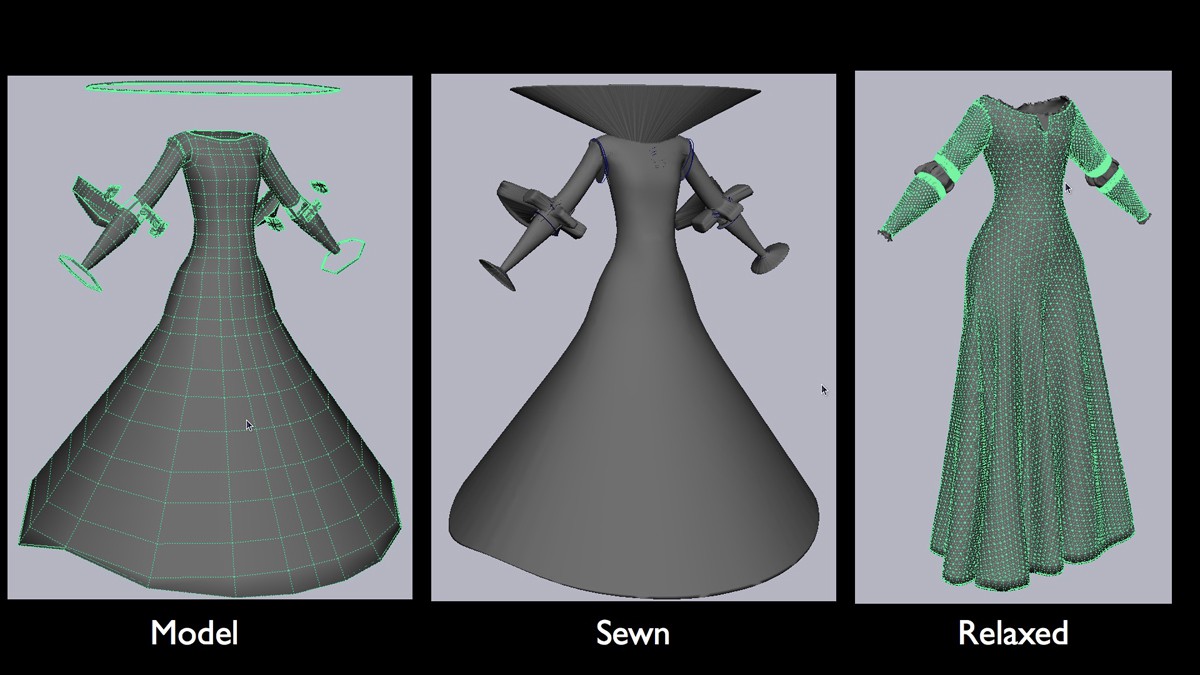How much detail should your simulation mesh have? When do you have too little? When is it too dense?
That's a good question.
I saw this image a week or so before I went to SIGGRAPH:
It's one of Merida's simulation gowns from Brave. I think they use a proprietary simulation software (it looks like some super variant of Qualoth to me), but look a the detail they have in the final mesh. When I went to SIGGRAPH I was lucky enough to ask Claudia Chung (!!!) a question. What are their simulation times like? Did they have to wait minutes and minutes per frame, or was it a little faster? She told me that if it was taking longer than a minute or two a frame, then something was very, very wrong.
For people with average computers like me, I show them this:
(click to view the original size)
Which one of these resembles your simulation mesh?
#1 Doesn't have enough information. You can work with it, but it probably won't fold well over corners and you won't get nice billowing and wrinkling in your cloth.
#2 Is great and my personal choice. Sim times are good, and you can get great detail (wrinkles, billowing as the character moves, nice overlap) out of it.
#3 Is too much. If you have a fantastic computer, you might be able to pull it off. Maybe.
#4 ... I hope your computer has a will.
I will say this. Not every cloth object needs to have the same amount of detail. If it's something that's not seen as much (like an underskirt), see if you can get by with less. The same goes if your final cloth mesh is thick. Thick cloth (like leather) wouldn't billow in the wind and fold in on itself as much as something thin (like silk), so you could probably get by with less detail.
EDIT:
Here's something else to keep in mind.
As a reader and colleague pointed out, the poly count of your mesh is also linked to how your simulation works, not just it's visual level of detail. Take for example the four planes above. The same settings wouldn't work for all four planes. If you get the first one to work with a stretch resistance value of 30, the second one will probably need a stretch resistance value of 65 or 70 in order to behave, and so on and so forth.
~Melissa
That's a good question.
I saw this image a week or so before I went to SIGGRAPH:
It's one of Merida's simulation gowns from Brave. I think they use a proprietary simulation software (it looks like some super variant of Qualoth to me), but look a the detail they have in the final mesh. When I went to SIGGRAPH I was lucky enough to ask Claudia Chung (!!!) a question. What are their simulation times like? Did they have to wait minutes and minutes per frame, or was it a little faster? She told me that if it was taking longer than a minute or two a frame, then something was very, very wrong.
For people with average computers like me, I show them this:
(click to view the original size)
Which one of these resembles your simulation mesh?
#1 Doesn't have enough information. You can work with it, but it probably won't fold well over corners and you won't get nice billowing and wrinkling in your cloth.
#2 Is great and my personal choice. Sim times are good, and you can get great detail (wrinkles, billowing as the character moves, nice overlap) out of it.
#3 Is too much. If you have a fantastic computer, you might be able to pull it off. Maybe.
#4 ... I hope your computer has a will.
I will say this. Not every cloth object needs to have the same amount of detail. If it's something that's not seen as much (like an underskirt), see if you can get by with less. The same goes if your final cloth mesh is thick. Thick cloth (like leather) wouldn't billow in the wind and fold in on itself as much as something thin (like silk), so you could probably get by with less detail.
EDIT:
Here's something else to keep in mind.
As a reader and colleague pointed out, the poly count of your mesh is also linked to how your simulation works, not just it's visual level of detail. Take for example the four planes above. The same settings wouldn't work for all four planes. If you get the first one to work with a stretch resistance value of 30, the second one will probably need a stretch resistance value of 65 or 70 in order to behave, and so on and so forth.
~Melissa


No comments:
Post a Comment